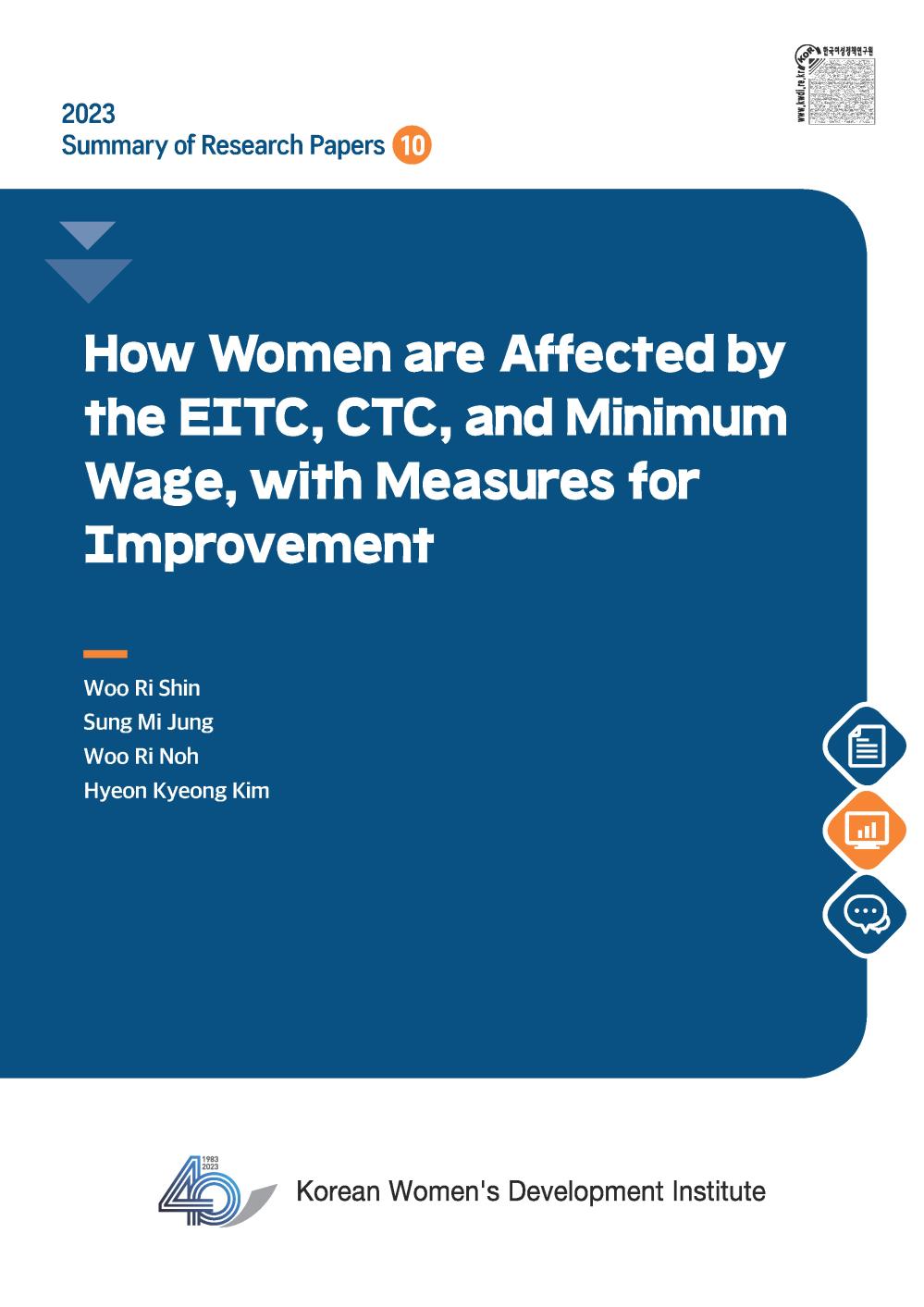Report
| How Women are Affected by the EITC, CTC, and Minimum Wage, with Measures for Improvement | |||
|---|---|---|---|
| Type | Basic | Period | 2023 |
| Manager | Woo Ri Shin | Date | 2023-12-29 |
| Fiie | 10_근로자녀장려세제와 최저임금제도가 여성에 미치는 영향과 개선방안 연구.pdf ( 1.66 MB ) | ||
|
Abstract How Women are Affected by the EITC, CTC, and Minimum Wage, with Measures for Improvement Woo Ri Shin Sung Mi Jung Woo Ri Noh Hyeon Kyeong Kim
In this study, we look at the impacts of the Earned Income Tax Credit (EITC), Child Tax Credit (CTC), and the minimum wage on women, with a view to discussing measures for improving these schemes. To this end, we examined how changes in the minimum wage affected, by gender, wage levels and the incidence of minimum wage noncompliance in wage earner labor markets for women. We also look at the employment effects of EITC and CTC by analyzing changes in employment rates and work hours before and after receiving EITC or CTC payments. Finally, we categorize groups affected by these three schemes according to institutional eligibility. We then explore each group’s characteristics and changes in household work hours and labor income attributable to eligibility, thus informing a discussion of how these programs might be improved upon.
With regards how minimum wage changes affect women wage workers, we drew on the Regional Employment Study of Statistics Korea, focusing on women affected by the minimum wage to analyze employment effects among them. We found that as of 2021, the incidence rate of minimum wage noncompliance for women stood at more than twice that for men, with the discrepancy being unaffected by the upward trend in the minimum wage. Looking at characteristics by group, noncompliance was markedly high among elderly women, pointing to the need for monitoring and supervision over jobs worked by this demographic. Furthermore, noncompliance was also relatively higher among women of low education in temporary / daily positions. By industry, minimum wage noncompliance was high mainly in sectors with a high share of women labor, such as manufacturing, wholesale and retail trade, accommodation and food services, and human health and social work activities. Noncompliance tended to taper off in most industries following the sharp minimum wage hike of 2018, but has continued to rise steadily in areas such as water supply, sewage, waste management (i.e., cleaning-related), transportation and storage, real estate services, business support services, public administration, education, and in-home employment.
With regards to the effects of EITC and CTC on women’s employment, we drew on data from the Korea Welfare Panel Study to summarize changes in employment rates and yearly work hours before and after receiving EITC or CTC payments. Then, we employed panel data analysis to look at the employment effects among recipients by controlling for individuals’ unobserved fixed effects. EITC appears to have boosted work activity among women householders in the 60+ age group throughout the phase-in range of income (i.e., where minimum wage is applicable), mainly via public jobs programs. Meanwhile, work hours were reduced among women who were spouses of householders. Employment among the elderly provides not only jobs but also income support, encouraging the elderly to keep up an adequate level of activity while alleviating the state’s fiscal burden through a combination of basic pensions and public assistance. This is particularly relevant for societies with high poverty rates among the elderly, such as Korea. That said, the rising share of female householders among EITC recipients and the much lower levels of assets held by women relative to men indicate that households headed by women still face greater economic hardships compared to those headed by men. Looking at the impact of the COVID19 pandemic, it is easy to find indicators that single-parent households were the hardest hit financially. This appears to be due to the fact that women’s already-disadvantageous position in the labor market (e.g. lower employment rate and lower wages) becomes mutually compounded with the double burden of care labor.
In our analysis of the characteristics of the groups affected by the EITC, CTC, and minimum wage, we employed data from the Korea Welfare Panel Study. For a given year, we defined minimum wage(MW)-affected workers as those who were paid lower than the minimum wage of the following year. MW-affected households were variously defined as those having a MW-affected householder, where either one of the householder couple was MW-affected, or where any household member was MW-affected. Further, a total of 6 household categories were defined according to affected or eligibility: households that are only MW-affected, households that are eligible only for EITC, households that are eligible only for CTC, MW-affected households that are eligible for EITC, MW-affected households that are eligible for CTC, households eligible for both EITC and CTC, and MW-affected households that are eligible for both EITC and CTC. Looking at how eligibility affected annual work hours among households in the following year, we found that the work hour-boosting effect became more significant among households that were only MW-affected the broader MW-affectedness was defined. This suggests that the effect is stronger among secondary earners (e.g. householder’s spouse, child, parent, etc.) than among primary earners (i.e., householders). Looking at how eligibility affected annual household income in the following year, no significant changes in household income were found among households that were only MW-affected, while an increase in annual household income was observed among MW-affected households that were eligible for EITC.
Research areas: Labor?Employment Keywords: Minimum Wage, Earned Income Tax Credit, Child Tax Credit, Women labor |
|||
